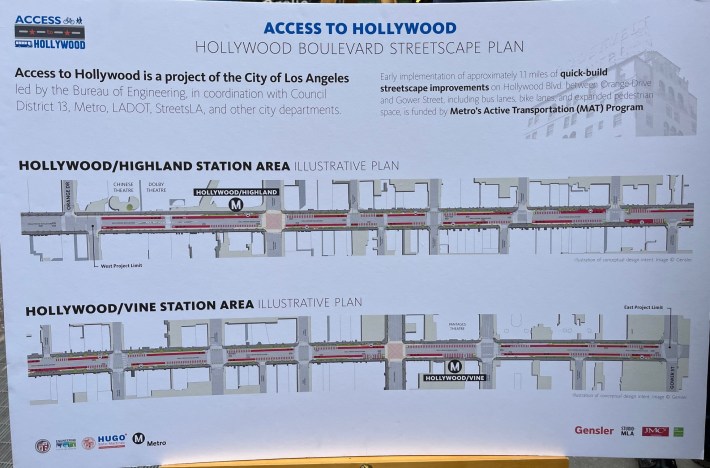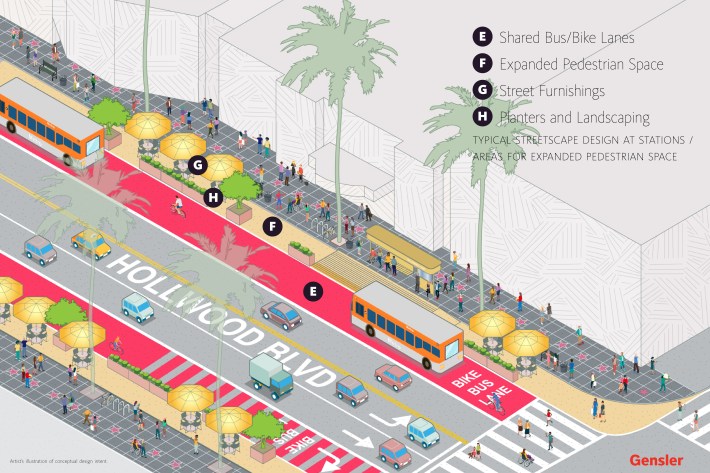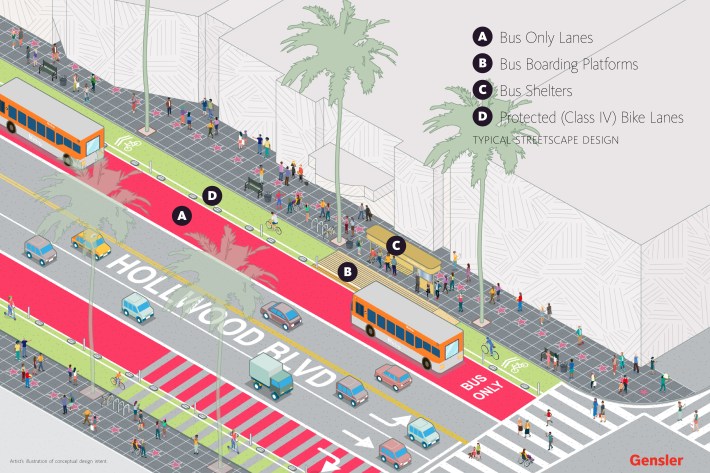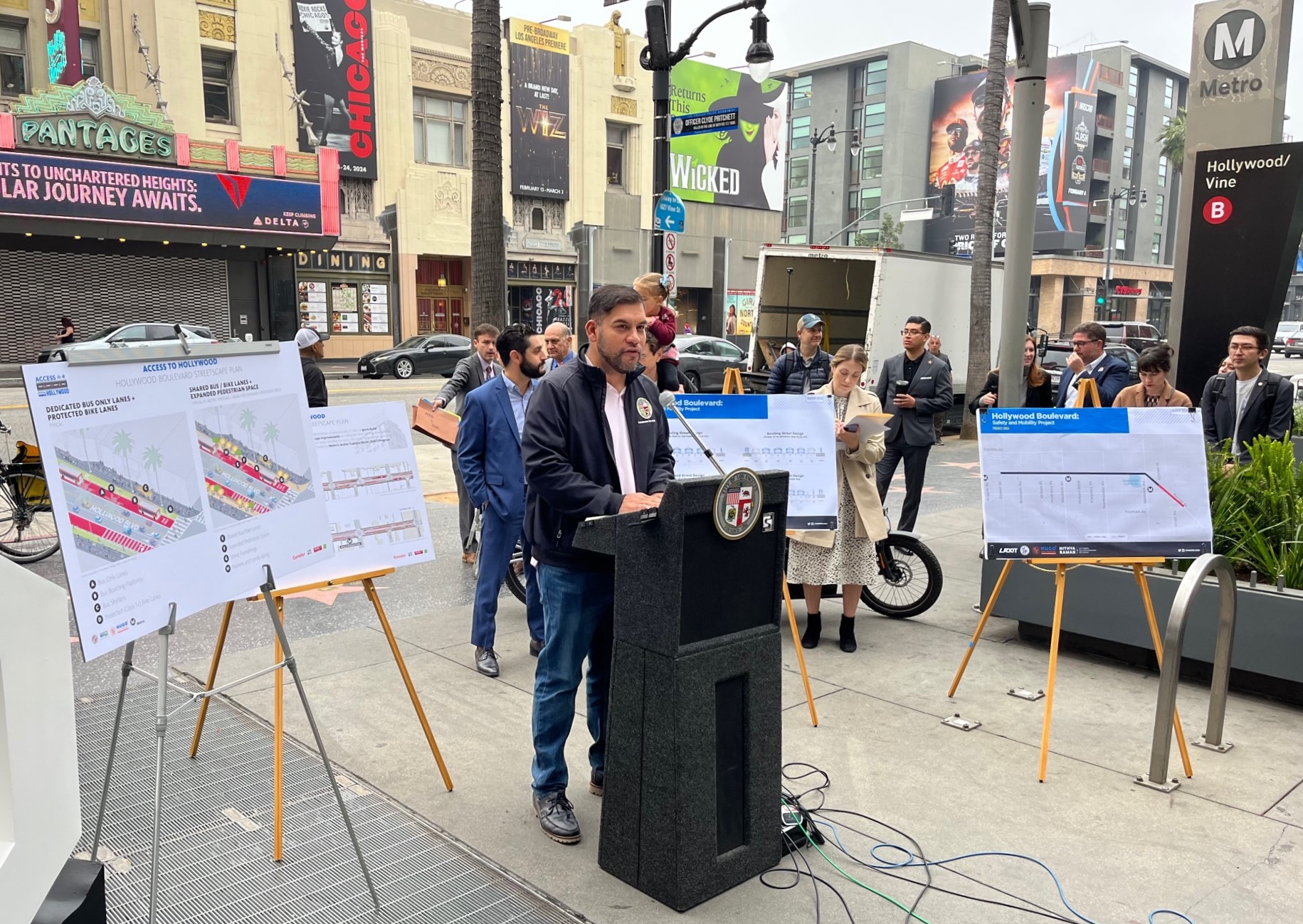
This morning, the city of Los Angeles announced significant bus, bike, and walk upgrades to iconic Hollywood Boulevard. At a press conference at the Hollywood/Vine Metro B Line portal, speaker remarks were sometimes difficult to hear due to car traffic noise from Hollywood Blvd.
This part of Hollywood Boulevard is a world-renowned attraction, but there isn't all that much to see. There's a longstanding joke that Hollywood attracts ten million tourists a year, each of whom spend about twenty minutes there. Some locals avoid the area, as it suffers from traffic congestion, homelessness, and many forgettable businesses catering primarily to tourists.
This morning, L.A. City Councilmember Hugo Soto-Martinez praised the Hollywood Boulevard improvements as improving safety and inviting people to come and stay and shop, supporting local businesses. A representative for Councilmember Nithya Raman, Soto-Martinez's collaborator on the project, stressed benefits to the area's many car-free households. The city Transportation Department's (LADOT) representative Claire Eberle touted improved safety for all road users, also noting that bus lanes will mean faster emergency response times.
The overall project consists of two abutting Hollywood Boulevard stretches being improved collaboratively by two different city departments.
- LADOT's Hollywood Boulevard Safety and Mobility Project will extend 2.3 miles from Fountain Avenue to Gower Street
- The city Department of Public Works Bureau of Engineering (BOE) "Access to Hollywood" project will include quick-build upgrades on 1.1 miles from Gower Street to Orange Drive - the famous Hollywood Walk of Fame. BOE is the lead agency for this stretch, where it is collaborating with LADOT, Bureau of Street Services (StreetsLA), and Metro.

Streetsblog covered the LADOT's Hollywood Boulevard project in detail last month. To improve pedestrian, cyclist, and driver safety LADOT is reconfiguring the street, removing a travel lane (termed a road diet) or eliminating some on-street parking in some stretches. This frees up space to add Council District 13's first stretch of protected bike lanes, nearly all parking-protected.
The LADOT project connects to three Metro B Line subway stations, population-dense neighborhoods of Hollywood and East Hollywood, commercial areas (with outstanding restaurants) in Thai Town and Los Feliz, health care services/jobs clustered on Sunset, historic Barnsdall Art Park, and more.
The good news today is that the LADOT project has been extended an additional third of a mile to Fountain Avenue, where it will connect to existing bike lanes on Sunset Boulevard. That stretch is where Sunset4All is proposing a major transformation.
BOE's Access to Hollywood is an early phase of the city's Heart of Hollywood project. That underwhelming ostensibly first/last mile subway stations project was developed under former anti-bike councilmember Mitch O'Farrell, and is now being retooled by Soto-Martinez.
The initial quick-build phase features about a mile of new bus lanes, plus painted curb extensions (basically expanded sidewalks), and bike lanes. The bike lanes include sections that are plastic-bollard protected, plus many areas where cyclists share the bus lanes.



The shared bus/bike lanes will be better than what is there today, but are not optimal. Many have called for making portions of Hollywood car-free in the Walk of Fame area.
Shared bus/bike lanes are likely to see many cyclists preferring to ride in adjacent pedestrian areas. Outside the most crowded areas (mainly at/near Hollywood and Highland) and heaviest tourist times of day/year, perhaps the curb extensions can work as sort of mixing zone where pedestrians and slower moving cyclists share space.
Construction is anticipated to get underway later this year and be completed in the first half of 2025.







